Black Orpheus Chords: Reharm Tips and Tricks
 Want to learn some special Black Orpheus chords? Want to play chords that are hipper than the basic chords an average musicians play?
Want to learn some special Black Orpheus chords? Want to play chords that are hipper than the basic chords an average musicians play?
Well, in today’s free video lesson, we’re going to show you some really hip sounding reharmonizations for the intro to Black Orpheus.
This lesson will give you ideas about how to play Black Orpheus in a more interesting & exciting way.
Black Orpheus Chords Reharmonization Video
First, watch this quick video to give yourself a head start. Afterward, scroll down to learn how to master all these jazz reharmonization moves.
How The Jazz Inner Circle Doubled Andrew’s Playing Skills
By the way, I’m very proud to announce that Andrew (the great teacher in this video) is one of the graduates from our Jazz Inner Circle Program.
We are really proud at how great his playing is sounding and the huge meteoric success he’s had through working with Steve in his private 1 on 1 jazz mentorship.
Basic Black Orpheus Chords For the Introduction
Before you try and change anything up in this tune, you got to know what are the basic chords of the tune.
Learning these chords first will give you the direction you need. This will also give you what options you might possibly have to reharmonizes and make it sound more interesting.
The basic chord progression for the intro the tune goes like this:

The chord progression is simple and works well. However, you can do a lot more to make it sound way more cool than that.
How would you do it? Read below.
Learn the Melody of Black Orpheus
 Let’s study and try what Andrew was doing with these Black Orpheus chords.
Let’s study and try what Andrew was doing with these Black Orpheus chords.
If you’re wondering about how he gets to reharmonize chords in such a hip way, you have to learn the melody first.
By knowing the melody and the key of the tune, we can figure out what chords would match each note.
The melody along with the key the tune is in forms the basis for reharmonization.
Play a Basic or Familiar Chord First
 In the beginning of the reharmonization, Andrew started out with the Dm7(11) chord.
In the beginning of the reharmonization, Andrew started out with the Dm7(11) chord.
Notice that he did not substitute it with anything else. Why?
Because something familiar has to be established first.
When we say something familiar, it’s something anyone would expect to hear.
We know that the tune Black Orpheus is in Am, and that the introduction starts out with the iv chord, which is Dm.
How to Reharmonize the Other Black Orpheus Chords
 Here’s the really exciting part! This is the part where you try out chords that in normal situations are unexpected.
Here’s the really exciting part! This is the part where you try out chords that in normal situations are unexpected.
Now you’re probably asking, what chords I can substitute for Am7? Maybe you might be asking how did Andrew figure that out?
We said earlier that you need to know the melody first. In reharmonization, you need to consider three things:
Do You Know These 3 Reharm Steps?
1. A chord that has at least one note from the melody. The melody note should be the top most note.
2. The chord must make sense as a resolution from the previous chord.
3. The chord voicing of choice should have some kind of melodic motion from the previous chord.
You can learn more about reharmonization tactics through this harmony theory lesson.
Look at how Andrew plays it out. From a Dm7(11) he moves to a C#m7(11).

Did you notice how the movement is chromatic from one chord to the next?
You saw and heard that the melody note moved from C to B. We can use this chromatic movement (movement by just half steps) as a pattern for the next chord change.
Chromatic movement makes it possible for you to substitute Am7 with C#m7. Not only does the melody note move chromatically, all other notes move in the same way. This adds a feeling of tension.
Ramp Up the Tension with the Next Few Chords
 From C#m7(11) what other exciting chord can you use to substitute for a Dm7(11)? To figure that out, you can exploit common tones.
From C#m7(11) what other exciting chord can you use to substitute for a Dm7(11)? To figure that out, you can exploit common tones.
Common tones are a big part in reharmonization whenever you try to learn jazz song endings.
The next melody note is C. What chord can you use that has a C plus a note that has a common tone with C#m7(11)? Andrew figured it is an Fm7(11) with a C on the bass.

After the Fm7(11), Andrew plays a B7(sus4) chord that voiced in a particular way. Refer to the chart below:

To make things a lot more interesting, Andrew pauses at the B7 chord and throws a B7 Phrygian arpeggio as an embellishment:
That pause is an opportunity for some jazz improvisation, kind of like the candenza in classical music concertos.
Resolving the Black Orpheus Chords
 Using common tones and chromatic movement, Andrew then resolves all that tension created a few measures ago. A lot of jazz reharmonization involves creating tension and resolving it.
Using common tones and chromatic movement, Andrew then resolves all that tension created a few measures ago. A lot of jazz reharmonization involves creating tension and resolving it.
Check out how Andrew plays the next few measures in the chart below:

As you might have noticed, Andrew sets up a II – V chord progression with the D7(#11) then G7(13,b9). He then uses a lot of chromatic movement to resolve down to an Em7(11) then plays a highly sophisticated ending with the E7(b13,#9) and Eaug chords.
How To Play The Best Chords That Audiences Love To Hear
 Do you want to discover a massive collection of rich chords like the ones in this lesson?
Do you want to discover a massive collection of rich chords like the ones in this lesson?
Want to do so 24 hours a day in the comfort of your own home?
If you want to be able to come up with your own sophisticated versions of chords and tunes like Andrew, we have a course that shows you how to play hundreds more of these kinds of chord voicings.
More than just learning those chords, you will learn how to use such devices inside real jazz music that audiences love to hear.
Get you own playing to a really hip and sophisticated level inside this awesome course —–> Premium Jazz Elite Membership Course
So, have fun practicing these reharmonized Black Orpheus chords and incorporate it in your own playing. Remember to try these chords out in various keys so you can incorporate them in to other tunes.
We Are Really Proud Of Andrew’s Success
P.S. I’m really impressed with the mix of chord styles he used in this one. He’s got modal, phrygian, McCoy Tyner style, and Brazilian style chords.
As his jazz mentors, it brings a smile to our heart to hear how amazing his harmonies are. If you want your chords to sound like that too then take the next step today.
Apply to work 1:1 with Steve & Jazz Grammy Nominees here https://www.freejazzlessons.com/inner-circle
